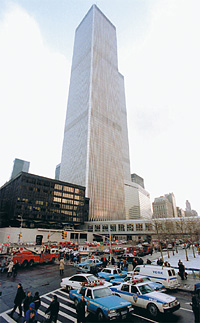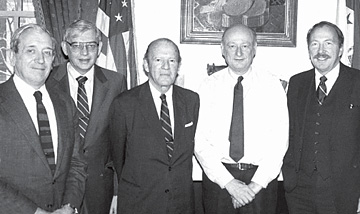| The first attack
It was shortly after noon on Friday, Feb. 26, 1993, when a loud explosion rocked the World Trade Center. Sitting at their desks on the 27th floor of Two World Trade Center, JoC staffers felt the building move. Immediately, computer screens went blank, phones and lights went dead. Work on Monday’s edition of The Journal of Commerce came to an abrupt halt.
| 1993 bombing didn’t stop JoC |
“It must have been a truck bomb,” said Don Becker, then-publisher of The Journal of Commerce, as he rushed into the newsroom from his corner office.
Staff members looking out the window saw people at the World Financial Center across West Street staring up at the twin towers. They could also be seen gazing down at the entrance to the Trade Center’s parking garage, leading to speculation that it had been a car bomb on the street. Radio reports indicated that there may have been a transformer explosion.
 |
The chaotic scene outside the World Trade Center on Feb. 26, 1993. The bombing forced the JoC from
its headquarters, but it didn’t prevent it from publishing.
Reuters |
Soon smoke started rising up the elevator shafts and stairwells. Most staffers initially remained in the office, where the smoke had not yet penetrated, rather than walking down the stairs immediately. One reporter left the building the way he always did, by elevator.
Someone discovered a phone in the computer room that was still working and called 911. The police advised that everyone should leave immediately. By that point, most were on their way out anyway, leaving behind purses and coats. The stairways were crowded and smoky, and many took wet paper towels to help them breathe. Two reporters waited on the 20th floor for a half an hour for the stairways to clear, then found another stairway that was clear of smoke and people.
| “If someone told me an airplane had hit the building, I wouldn’t have been surprised.” |
Some stayed behind to make sure everyone else got out safely, including a group of customers on site for a PIERS training session. As the smoke filtered into the office, reporter Greg Johnson went around on his hands and knees, patting every chair to make sure no one was still there. “That’s because one visitor was so frightened that he locked himself in the bathroom,” recalled Johnson.
Editor Scott Bosley and managing editor Howard Abramson set up temporary headquarters at the company apartment across the street in Battery Park City. Plans were made with Don Amerman, managing editor at the paper’s Phillipsburg, N.J., production plant, and Washington Bureau Chief Tom Connors, to publish Monday’s paper with whatever articles could be found. Many stories had already been written. One that wasn’t and that was scheduled for the front page was based on an editorial board interview that morning in Bosley’s office with the transportation minister of Canada. A truncated version of the paper was published on schedule.
Although the newsroom was closed for a month, the JoC plowed ahead. Reporters and editors took up temporary quarters in various locations including Phillipsburg and Washington. Most New York-based reporters, along with the advertising, circulation, marketing, administrative staff and PIERS personnel, crowded into the Wall Street office of Knight-Ridder Financial News. For one reporter, it turned out to be a happy experience. Dane Hamilton met his wife at the KRF office.
The Journal of Commerce continued publishing, just as it did in 1989 when an explosion at a power station near the South Street Seaport forced the company out of its then-headquarters at 110 Wall St.
The March 1 issue, the first after the bombing, also featured a front-page column that transportation editor Ira Rosenfeld had dictated by telephone to Phillipsburg. Headlined “JofC Staff All Pulled Together,” the article contained this observation: “If someone told me an airplane had hit the building, I wouldn’t have been surprised.” |


